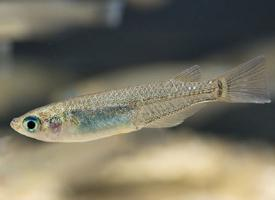
Greutăți și măsuri
| Lungime | de la 2 la 4 cm |
|---|
Starea de conservare
| Neînfricat |
Descrierea animalului
The Japanese rice fish, scientifically known as Oryzias latipes, is a small, captivating species of freshwater fish that is native to East Asia, particularly Japan, Korea, and parts of China. This species is highly adaptable and can thrive in various aquatic environments, ranging from slow-moving rivers and streams to rice paddies, marshes, and even slightly brackish waters. Their remarkable adaptability and the ease of breeding them in captivity have made them a popular choice among aquarium enthusiasts worldwide.Physically, the Japanese rice fish is diminutive, with adults typically reaching lengths of only 1.5 to 2.5 centimeters, though some may grow slightly larger. They exhibit a slender, elongated body that is almost transparent, allowing a clear view of their internal organs, a feature that has piqued the interest of scientific research, particularly in genetics and developmental biology. The dorsal and anal fins are positioned far back on the body, near the caudal fin, which is moderately forked, aiding in their swift and agile movement through water.
The coloration of the Japanese rice fish varies widely, from a natural muted palette of olive green and brown to brilliantly colored strains that have been selectively bred for the aquarium trade. These cultivated varieties display a range of hues, including orange, red, and even metallic shades, adding to their appeal among hobbyists. The males of the species are generally more vibrantly colored and slightly smaller than the females, which are often plumper, especially when gravid.
One of the most intriguing aspects of the Japanese rice fish is their breeding behavior and reproductive biology. They are oviparous, with females laying adhesive eggs on aquatic vegetation or other substrates. The males then fertilize the eggs externally. The species is known for its unique mating dance, where the male impresses the female with a display of swimming patterns and body vibrations. After fertilization, the eggs hatch within about 10 days, depending on the temperature of the water, with warmer conditions accelerating development.
The Japanese rice fish is not only significant in the aquarium trade but also plays a vital role in scientific research. Its fully sequenced genome and the transparent nature of its embryos make it an excellent model organism for studies in genetics, toxicology, and developmental biology. Researchers have been able to observe developmental processes in real-time, contributing valuable insights into vertebrate development and genetic regulation.
In terms of care, the Japanese rice fish is relatively low-maintenance, making it an excellent choice for both novice and experienced aquarists. They thrive in well-oxygenated water with a pH range of 7.0 to 8.0 and temperatures between 20°C to 26°C (68°F to 79°F). They are omnivorous, feeding on a diet of small invertebrates, algae, and commercially available fish food designed for small freshwater species.
In conclusion, the Japanese rice fish (Oryzias latipes) is a fascinating and versatile species that has captured the interest of both the scientific community and aquarium enthusiasts. Its ease of care, interesting behavior, and potential for genetic research make it a valuable and intriguing addition to the world of freshwater fish.
Fotografii noi cu animale
Top 10 animale
- Dolphin gull (Leucophaeus scoresbii)
- Diana monkey (Cercopithecus diana)
- Moustached guenon (Cercopithecus cephus)
- Greek tortoise (Testudo graeca)
- Stone loach (Barbatula barbatula)
- Galápagos tortoise (Geochelone nigra complex)
- Japanese macaque (Macaca fuscata)
- Russian tortoise (Testudo horsfieldii)
- Common flying dragon (Draco volans)
- Galápagos penguin (Spheniscus mendiculus)